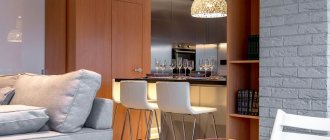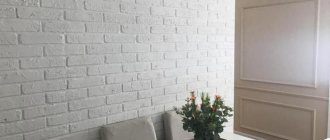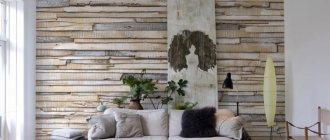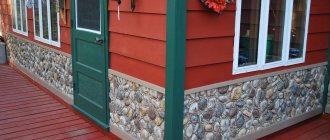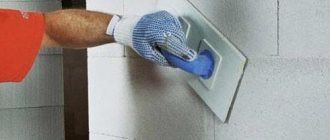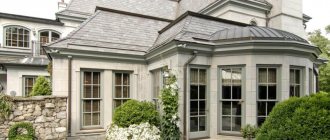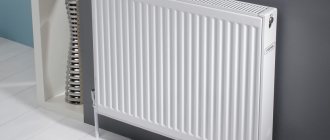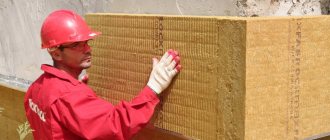What types of decorative bricks exist?
This finishing material is classified primarily according to the material used in its manufacture. More specifically, for this purpose they can use:
- gypsum;
- porcelain stoneware;
- cement;
- ceramics.
As for texture, dimensions or color, they can be different for each material; at the same time, they can be standard for various materials. And this is influenced not only by production technology, but also by the dyes used, ideas taken into account by the customer and the manufacturer.
Clinker tiles as finishing
In order to renovate an apartment, you can use an excellent replacement for brick - clinker tiles. This material is affordable and beautiful. Clinker tiles are produced from raw clay. The method of laying the material is practically no different from using simple tiles.
During manufacturing, the surface of the finishing material is covered with glaze, so the color of each element will be preserved for a long time. The matte relief of the tile is very difficult to damage even if the wall receives a strong blow.
The advantages of clinker tiles include:
- structure that is similar to brick;
- the ability to retain heat in the room.
As for the disadvantages, there is only one: clinker tiles have a high water absorption coefficient.
Even an inexperienced person can use the material. In order to make a brick wall using this tile, each part will need to be coated with glue and secured to the work surface. There must be a cross between each tile to secure the seams.
If you want a result as close as possible to the original effect of a brick wall, it is better to give preference to unglazed tiles. But it is better not to install such tiles in a room with high humidity.
view album in new window
In the photo: Living room interior in an eclectic style apartment
How are decorative gypsum bricks made?
The lightest raw material in the production of decorative bricks is considered to be gypsum, not only literally, but also figuratively. It weighs little and is extremely convenient to use, and therefore makes it possible to make facing material with your own hands directly at the workplace (we will talk about this in more detail a little later). What will it take? Quite a bit - actually plaster, molds for forming bricks, dyes, water and, of course, desire.
Note! To make it easier to remove finished elements from the mold, be sure to lubricate it. To purchase lubricant, you can visit your nearest hardware store. Exactly what type of lubricant should be depends on the material from which the mold is made.
By the way, you can also make such forms at home, for which you can use wood, the same plaster, concrete or foam plastic. Thanks to this, you will be able to obtain products with a texture and shape that no manufacturer of decorative bricks can offer. Next, you just need to knead the “dough” in a suitable container using a construction mixer, add the required dye, pour the resulting solution into a pre-greased mold and wait until it hardens completely. Such a simple technology can be mastered even without experience, learning from your mistakes. Fortunately, there is nothing super complicated about this.
Antique Brick Tiles
This is a solution for connoisseurs who dream of a real antique product and want to get as close as possible to the effect of an old wall. Today on the finishing materials market there are quite a few companies that sell and lay tiles from bricks obtained during the dismantling of ancient buildings.
High-quality decorative coating almost indistinguishable from the original
Tiles made from original 19th century bricks are often marketed with a specific designation of origin
Carefully cut antique brick has a standard clinker thickness of about 1.5 cm. It really looks amazing! Each “piece” of the finished product is different from all the others, and this is the effect we want.
This is an option for people who want to get authentic material to create the most authentic interior. The minimum thickness of the product almost does not reduce the area of the room, and there is no need to worry about the increased load on the load-bearing structures of the building.
When laying tiles from antique bricks, eliminate doubts about the professionalism of the tiler. Here, the decisive role is played by the competent execution of the seam joint , simulating a solution between the cladding elements!
Cement decorative brick - material features
Cement brick differs from the one described above, first of all, in its color and weight. The fact is that cement weighs more than gypsum. The first one is often gray (colored is less common), while the second one is white. As for other nuances, the technologies here are almost identical.
At the moment, you can find other dry materials/mixtures on the building materials market, the properties of which are similar to those of cement/gypsum. All of them can also be used to make decorative bricks for interior decoration.
Note! The main disadvantage of decorative bricks - made from both gypsum and cement - is their fragility, and therefore it is necessary to work with the material extremely carefully. At the same time, low strength characteristics can also be considered an advantage, since they make it easy to cut tiles if required during work.
Of course, such a material, made in an industrial environment, will be more attractive and durable than one made by hand. Its disadvantage can be considered the limited sizes and colors - you will have to be content with what the market offers.
Faux brick – which color to choose?
The choice of color for a future brick wall is often discussed by those who have chosen materials that imitate this material. We all know that the standard red-brown color is already quite boring. He looks quite rough, even wild. It’s as if there are simple, bare walls in front of you. Sometimes, if the interior is suitable, such qualities can be cleverly played up and taken advantage of.
But in recent years there has been a tendency to use colored bricks. Consider the style of the room itself, this will help you choose the right option. The most popular options:
- White. Ideal for bathrooms and kitchens.
- Black. It is often installed in the corridor or hallway, less often in the bathroom.
- Gray and beige. Unique colors, neutral, so they can go anywhere.
Important! If you want to create a cozy atmosphere, then install blue brick in the bedroom. If you need romance, red and similar tones are ideal.
Remember that most surfaces that only imitate brickwork can be easily painted in any color by you personally. The exception is white, which can even be applied to real brick. This style was first used in Scandinavia. Now it is considered an offshoot of minimalism. If you choose white brickwork, then try to be discreet when creating the interior.
You should not buy a large number of pieces of furniture and so on. This rule especially applies to paintings and other decorations. There should be practically no decor; we select furniture in purely classic colors. On the other hand, a white brick wall can highlight brighter colors. This trick is often used by stylists to make bright objects look even brighter.
Important! White is the most popular color of brickwork, if we are talking specifically about imitation of this material.
Grey colour
What about neutral colors? Red can be used in the bedroom, blue too, white is ideal for almost all rooms. But what to do with neutral colors that don’t grab attention with their brightness or specialness? Everything is very simple, you just need to place such masonry in a room where there are no accent objects. The ideal solution is corridors or hallways. Often such places have a rather restrained design.
This is what makes gray brickwork attractive. It brings aesthetics and seriousness to the room without making it too bright. Just imagine a red hallway? This will put unnecessary pressure on the guest and you at the very beginning. You should avoid such cases when creating your own interior. Try to ensure that the colors of the brickwork are perfectly matched to both the style of the room and its purpose.
Using granite chips and clay
Let's start with clay. It is the raw material from which ceramics are made. And if you add granite chips to it, you can get porcelain tiles. Ceramic and porcelain tile products are produced on an industrial scale because the molded tiles must be fired in kilns at very high temperatures. Doing this yourself, especially on a construction site, is extremely difficult. And artisanal manufacturers cannot guarantee that their products are truly of high quality.
Note! If you are planning to purchase porcelain stoneware decorative bricks, then proceed with extreme caution and contact only those companies that have all the necessary certificates.
The characteristics of ceramic/porcelain facing bricks are quite high. So, the material is difficult to split or break. It is also not easy to cut, and it practically does not wear out. Brick can also be wiped and washed without fear of damaging the color or texture.
Advantages and rules of choice
The main advantages of decorative bricks are:
- Long working life;
- Simplicity of cladding;
- Reliability, strength;
- A wide variety of shades and textures;
- Environmental Safety;
- Wear resistance;
- Good sound insulation characteristics;
- Fire resistance;
- Chemical neutrality;
- Possibility of application for various style options.
Decorative brick is a relatively new finishing material. It began to be widely used about 10 years ago. It is so easy to work with that you can do the cladding yourself. Durability and strength bring it to the TOP positions among finishing materials. And its environmental safety allows it to be used in any room, including children’s rooms. The color range is very diverse: shades of white, brown and yellow. The texture is a realistic imitation of natural brick. This is a universal building material. It can be used for cladding walls made of brick, cement, foam concrete and plasterboard.
Basics of making the right choice
When choosing a finishing material, you need to pay attention to what kind of material is used:
- Decorative artificial gypsum bricks absorb water, so they are not recommended for use in wet rooms.
- Ceramic brick is universal, so it is suitable for any room, including for finishing fireplaces and stoves.
- Cement cladding is equally suitable for exterior and interior decoration.
What about other methods of “brick” wall finishing?
On the modern building materials market there are many other finishing materials with which you can decorate the interior walls of a room with brickwork. Thus, flexible tiles made to resemble bricks are produced from polyvinyl chloride. Sometimes you can find collections of decorative panels made of MDV/PVC. These types of panels and tiles are characterized by the fact that they are not separate elements, but a kind of panel, the area of which reaches several square meters. All this can be mounted either directly on the wall or on a metal/wood sheathing. The cost of such panels is lower than the same decorative brick, and they are definitely easier to work with.
Price
The price of brick panels depends on several factors, which include:
- Material – MDF is usually more expensive than PVC.
- Manufacturer - Chinese and Malaysian products are the cheapest, Russian ones are somewhat more expensive, products from Europe and the USA can be 2 or more times more expensive.
- Brand awareness.
- The complexity of the drawing.
- The quality of the paints used.
USEFUL INFORMATION: Features of the construction of a Russian bath
Criteria for choosing decorative bricks
To correctly select the facing material described in the article, it is necessary to become more familiar with the materials from which it can be made. Let's start with plaster.
Material No. 1. Gypsum
In fact, this is by no means a moisture-resistant material, and therefore, to protect it from the negative effects of moisture, its surface must be coated with varnish or, alternatively, any other suitable protective agent. Due to the low moisture resistance (as well as fragility), gypsum cladding is used only in rooms without high humidity and threats of mechanical stress. In addition, there should be no need to frequently wipe down the walls.
Material No. 2. Cement
It is not afraid of moisture and has higher strength characteristics than gypsum, and therefore provides much more freedom in terms of use. But still, it is advisable not to use this decorative brick for interior decoration for external corners, which, as you know, are most often subject to impacts if, say, any heavy objects are carried.
Material No. 3. Ceramics
This material, which we described in more detail in the previous sections of the article, is characterized by the following qualities:
- it can withstand quite large mechanical loads;
- it is also porous, and therefore is considered a good heat insulator;
- the material does not deform under the influence of temperature changes;
- finally, it is frost-resistant.
Material No. 4. Porcelain tiles
A kind of analogue to the previous option, which differs:
- high strength characteristics;
- ease of washing;
- resistance to frost;
- protection from dirt and dust;
- moisture resistance;
- resistance to temperature changes.
Thanks to all these qualities, decorative bricks - both ceramic and porcelain stoneware - can be laid on almost any surface indoors, as well as in a veranda, terrace or loggia. Moreover, this facing material has proven itself well when finishing fireplaces, stoves and chimneys. And if necessary, it can also be used to decorate the external walls of a building. Finally, porcelain stoneware, due to its high strength characteristics, can also be used for flooring.
Types of finishing material
Decorative panels for brick interior decoration can be classified according to several criteria. They are made from different materials in any colors, can have different surfaces and additional coatings, which makes them universal in terms of finishing unique and individual interiors.
According to the type of material, “brick” panels are divided into:
- PVC. The products are made on the basis of polyvinyl chloride, which is supplemented with special softeners. The panels are light in weight and environmentally friendly. The plastic covering is securely mounted with glue and can be used to finish the ceiling. PVC brick panels are available in all colors and are inexpensive. Drawings are made on them using molds, applying paints or gluing a film with a three-dimensional pattern.
- MDF. To make such a coating, environmentally friendly wood chips are used, with which the future material will be characterized by high performance parameters. A minimal amount of formaldehyde is used to make the material, which makes it safe for human health. MDF panels are distinguished by wear resistance, durability, as well as heat and sound insulation properties. These products are most often used for interior decoration of residential walls. Sometimes they use a vandal-proof coating that even pets cannot spoil.
Chipboard, gypsum, plywood and hardboard are also used to make panels with a brick pattern. With them, the finishing material is much cheaper, but in operation it is inferior to models made from plastic or MDF. For example, some panel variations do not closely imitate brickwork, while others easily deteriorate under the influence of moisture or mechanical stress.
According to the specifics of installation, products are divided into the following types:
- Rack and pinion models. Such coverings are represented by oblong planks of different widths, which have grooves on one side for inserting an adjacent slatted plate.
- Plates. The products are produced as a set in the form of rectangular tiles. They are considered the best option for wall decoration, since it will be easier to select a pattern with them.
- Sheets. Panels produced in sheets can speed up the installation process of a large room.
Finishing materials can be made with a flat coating or a relief surface like a brick. The panels can be mounted in different ways. Usually, the instructions for the products contain the manufacturer’s recommendations, which must be studied so that problems do not arise during repairs.
Decorative brick in interior design - the best solutions
A large selection of raw materials in combination with modern technologies makes it possible to give such decorative bricks different colors, sizes or textures. Consequently, thanks to this, you can implement many decorative elements, not only for individual parts of the room, but also for the interior of interconnected rooms.
You yourself must decide how this or that room will look, what to use for finishing the entrance areas or the fireplace. But before that, it is advisable to consult a professional designer. Those who have education and experience in this matter will definitely help with the choice of facing material, taking into account the dimensions of the room and where the lighting sources are located. The general layout of the property, possible temperature changes, air humidity levels and, most importantly, the taste of the homeowners in relation to each individual room will also be taken into account.
How to choose a brick for interior decoration
The most important selection criterion is the aesthetic qualities of the material and its compliance with the chosen style. You can create an exclusive, truly unique atmosphere only with the help of brick that perfectly matches the design of the room. You definitely need to inquire about the consumer properties of the material and its technical characteristics. Don't be afraid to experiment with design. The properties of decorative finishing are such that non-standard decoration is guaranteed to you.
Examples of using. Photo
And now we suggest that you familiarize yourself with some examples of the use of the material described in the article for finishing walls from the inside.
Next you can see photographs of the use of decorative bricks to decorate the hallway.
Decorative plaster for brick
When we want dramatic changes in our interior, we should bet on something modern and bold. One such solution is to create a “brick wall” using decorative plaster.
And although for true connoisseurs of antiquity all options other than natural antique brick or tiles made from it do not count, decorative plaster is a quick and relatively simple way of radical renovation.
Decorative plaster creates an attractive coating, but it is far from the original
High-quality applied decorative plaster is in many ways similar to gypsum analogues, but much cheaper
Today there are several ways to create such decor. Which one to choose depends only on your desire and capabilities. You can find out more information about this technology in the article “Decorative plaster for brick.”
Laying features - what should you know?
So, you have made your final decision about decorating the room and now you want to find out what is better - to make decorative bricks for interior decoration yourself or to purchase it? Should you seek help from specialists or do everything yourself? When answering all these questions, it is necessary to take into account the lack/presence of knowledge and skills, as well as your financial capabilities. The time factor also plays an important role. Be that as it may, remember that professionals will do the job better and faster. Anyway.
If you decide to do everything yourself, then when choosing materials and raw materials, be sure to take into account the seller’s recommendations. He, having all the required information, will help with the selection of everything necessary - dyes, the brick itself, glue, mastic and tools, so that no difficulties or disappointments arise in the process. We also recommend that you consult with the seller regarding the preparation of molds, preparation of the mixture, time and conditions for drying the coating, and other important points.
Note! If you cannot get answers to all your questions in the store, then it is better to contact another retail outlet that will be able to provide full consultation.
And if you decide to hire professionals for the work, then you will have to coordinate the project, financing, monitor the timing and quality of implementation.
As for the cost of decorative bricks, it can vary depending on a number of factors, including the specific type and quality of raw materials, the reputation of the manufacturer, and production technology. You should not ignore discounts and trade margins, which also affect the final price. As an example, we recommend that you familiarize yourself with the average market value of some collections from popular manufacturers. For the convenience of site visitors, the information below is presented in table form.
Table. Prices for decorative bricks
It is also worth noting that the scope of this article does not allow us to cover the entire available range of the finishing material described. And the problem is aggravated because each of the collections consists of several sets that differ from each other in color.
Note! When coordinating projects for individual elements or rooms, consider whether the materials offered by the designers can be purchased nearby and whether they are supplied to order. In this case, everything will be done on time, and the total amount of repairs will not be very large.
Video - Making decorative stone
Brick finishing and style solutions
The “brick” finish gained great popularity after turning industrial premises into residential ones became fashionable. It was difficult to cover such apartments with wallpaper or plaster. To do this, one would have to commit real blasphemy - demolish all the walls and build them anew. Of course, no one did this, and the brick began its majestic march to the pinnacle of popularity. “Industrial aesthetics” is the founder of the popularity of decorative bricks.
In this article we will look at other design solutions and styles that successfully use the design and creation of “brick-like” elements.
Loft
It is worth telling in more detail about the loft style, which appeared precisely during the occupation of industrial buildings made of real brick. In the mid-twentieth century, this direction became the most in demand and popular. Many owners of ordinary apartments were so inspired after visiting loft housing that they began to refurbish their own in the same style.
Decorative brick will harmoniously fit into a loft-style interior
This fashion trend does not stand aside even now. To comply with all the style features, owners need to leave the pipework open and under the ceiling or along the walls, erect beams, and, of course, make brick walls. To avoid having to demolish old surfaces, residents everywhere use the decorative type of brick.
With the advent of such cladding, it has become much easier to turn your apartment or house into a real loft. But other interior styles can be perfectly complemented and transformed with the help of decorative brick stone.
Decorative brick for interior in loft style
Anyone who wants to create such beauty without moving to an industrial building or premises cannot do without brick walls. That is why the material we are considering is incredibly popular, popular and versatile.
Country
Also worth noting is the original country style, which also makes excellent use of brickwork. This interior is perfect not only for the home, but will also decorate a cottage or hunting lodge. The apartment can also recreate Western American design, as decorative brick is great for cladding and regular walls.
Decorative brick for interior in country style
If previously brick was left in the hunting house purely for economic reasons, so as not to waste effort, time or money on finishing, now they are specially creating an imitation of such a natural coating. Many people adjusted the design of the premises precisely because of the savings on creating cladding, because they do not hold receptions in a country house, and they come extremely rarely.
Country style allows you to create your own special atmosphere, indicating the distance of housing from the bustle of the city.
Gothic
The next style in which decorative brickwork can be introduced is Gothic. Neo-Gothic is also suitable for introducing such a design move. As you know, this style of interiors existed during the Middle Ages. Knight's castles and monasteries were mainly built of brick, and the walls simply could not be lined with special materials. All that the ancient rulers could come up with was to cover the walls with fabric or tapestries.
Wall decoration with decorative bricks for a Gothic style interior
Modern designers offer to introduce notes of Gothic to add majesty and pristine beauty to natural stone. Most often, such an interior contains only elements with brickwork: the design of part or only one wall, columns and arches can also be faced with decorative stone “like brick”.
Facing the arch with decorative bricks
This contrast creates truly impressive views: for example, a wide, massive canopy bed made of silk or velvet will look great against a brick background, or a crystal chandelier suspended against a pointed arch made of aged brick stone.
Minimalism
Who would have thought, but in minimalism decorative brick looks no less chic and impressive than in other styles already listed. For such an interior, you should select materials of brown, red or brown color - the shades will combine perfectly with floors, furniture and walls in white, black or gray. The designers claim that brickwork in this case will perfectly emphasize the main theme of the design - the urban essence.
Dark decorative brick for a minimalist interior
If you do not want to create such a bright image, then in minimalism you can use the neat white color of decorative brick for interior decoration. Or other light shades that bring only a little variety due to their non-standard, more rhythmic texture.
White decorative brick for a minimalist interior
The best use for decorative brick in any interior is to create unique accents. It is best to finish a separate wall, for example in the bedroom behind the bed or in the living room behind the sofa or TV. In the dining room, decorative brick will look great on the wall near the dining table.
In any case, no matter how you decide to use decorative brick in your interior, it will serve you for a long time, reliably, and will give you a lot of pleasant evenings. With the help of this finishing material you can create coziness, majesty, and uniqueness of any room. Your interior will be irresistible and original with a minimal investment of time, effort and money.
Gypsum imitation of decorative brick - detailed instructions!
As noted earlier, gypsum is inexpensive and accessible, and therefore a very popular material. To make the simulation described below, prepare everything you need to get started:
- fired gypsum (known as alabaster, a material used in construction and sculpture);
- building level (as an option, you can just use a long strip);
- dye;
- masking tape;
- colorants;
- brushes;
- primer;
- rollers;
- putty knife.
Note! The finished decorative brick on the wall can later be decorated using, for example, a sponge and painted.
Before starting work, cover the floors of your work areas with film or cardboard. We also recommend using latex gloves so as not to wash the plaster off your skin. Well, everything is ready, and therefore we can get down to business. Instructions are given below.
Step one . First, the walls are treated with a primer and, when it is completely dry, the fragments are marked and the walls are marked with a pencil. You can only draw the boundaries within which the gypsum mass will be located.
Step two . After drawing the steps of the bricks, the contours are carefully covered with masking tape. The lines must be pasted over the outside so that the bas-relief does not penetrate beyond the contour. Next, the gypsum is diluted with water to the required consistency (somewhat thicker than sour cream); The mixture should not slip.
The mass is poured unevenly with a spatula so that the future “bricks” are not uniform. In this case, the thickness should be a maximum of 1-2 centimeters. Gypsum, as noted earlier, has a rather fragile structure, and therefore a strongly protruding cladding element can accidentally break off. The work is carried out in stages - do not fill the entire area at once. The material dries quickly, and therefore work with the prepared mixture should be completed in a maximum of an hour. For example, to make 0.5 meters square - start sculpting decorative bricks.
Using a lath or a building level, you need to make horizontal markings in the wet material (using a knife or spatula), and ready-made “bricks” are cut out of the finished strips (only asymmetrically). After drawing an approximate drawing, the elaboration of the elements begins. In this case, you can lightly moisten individual areas with water if they dry out too quickly. Texture can be achieved by brushing in some places with a dry, rough brush, while smoothing can be done with a wet and soft brush. Upon completion of the procedure, the next section is sketched.
Step three . After drying, the surface is lightly sanded with fine-grain sandpaper, and then you can paint it as you wish. Or you can paint with a brush/roller with transitions or in one tone. Then, using a sponge, patina the protruding elements so that they turn out lighter or, on the contrary, darker. It is only important that the wall acquires a suitable shade that harmoniously fits into the interior of your room.
Note! If you do not want or cannot sculpt imitation masonry by hand, you can cast plaster bricks using a wooden mold. Lubricate the inside of the mold with Vaseline and then fill it with plaster. Then, when the material is dry, turn the mold over to remove it, paint the element and glue it in the desired location. Make sure that the look of the bricks is worn and vintage, which can be achieved by using torn edges, texture and colors.
As a result, we note that if the case is especially “old”, and the shade was given a dark color, upon completion of the cladding, you can treat the convex areas with a dirty dark or black color, but do not do this everywhere! If you want, you can subsequently cover the entire finished area with varnish (give preference to acrylic). Later, in order to change the interior or “to suit the mood,” the colors can always be changed.
That's all. We also recommend watching the thematic video below. Good luck with your work!
Homemade wall design options for brickwork
If you want to save money by making an imitation of brickwork on one of the walls of an apartment or house with your own hands, you can use original techniques developed by folk craftsmen.
There are interesting technologies that allow you to imitate brickwork completely independently.
There are several common options that do not require special costs for the purchase of facing slabs or panels, and also do not create any particular difficulties in installation:
- Self-production of polystyrene foam tiles with a thickness of 10÷12 mm. For this purpose, it is recommended to use extruded material with higher performance indicators than conventional white foam.
- Creating a brickwork relief using a stencil.
- Reproduce the desired design on the wall using masking tape.
Brick-like tiles made of polystyrene foam
If you plan to use the process of melting the edges of foam plastic in the manufacture of tiles, then the work should be carried out outdoors, protecting the respiratory tract with a respirator, since this material is flammable and releases toxic substances when burned and melted.
To be honest, using polystyrene foam for interior decoration is still not a reasonable solution.
- The first step is to mark the “brickwork” on the prepared, leveled and primed wall surface using a ruler, plumb line, building level and a simple pencil. The wall is drawn into horizontal stripes and vertical partitions, which determine the size of the bricks and the seams between them and the masonry rows.
- The second step is to mark the sheet of polystyrene foam into tiles of the selected size.
Sliced polystyrene foam rectangles are the future “bricks” of finishing
- Then the material is cut into individual elements with a stationery knife. The number of such blocks must correspond to the number of bricks required to decorate a certain section of the wall on which the marking was made.
Smooth tiles will not give the desired effect, so they need to “spoil their appearance” a little
- Next, in order to achieve the most reliable effect of imitation brick, you need to work on the resulting tile - this can be done in different ways. Its surface is treated with sandpaper in different or one direction, and notches and grooves are made on it with a knife or other sharp instrument. You can also use a heated soldering iron for these purposes.
Melting the edges of the tile using the fire of a lighter
Another option is to melt the edges and outside of the tile using a regular lighter or torch. In this case, the front surface takes on soft, smooth shapes.
Expanded polystyrene processed tiles arranged in “brickwork”
- After painting the tiles in the chosen color, its relief will be more pronounced. Paint can be applied before installing the tiles or after the wall cladding is completely completed.
Painting can be done using a brush or spraying the coloring composition from a can. The main thing is that the paint does not cause dissolution or softening of polystyrene foam - it is better not to experiment with organic-based compositions, giving preference to water-soluble ones.
The same “brickwork” but after the painting operation
- Laying of foam tiles is carried out according to wall markings using “liquid nails” glue, which is applied to the back surface in three points with a thickness of 3–4 mm.
- The final stage will be the design of the seams between the bricks and rows.
- It should be noted that if the design does not provide for highlighting the tile joints with a different color, then painting the cladding can be done after the grout solution has dried.
Imitation of brickwork using a stencil
In order to make an imitation of brickwork using a stencil, you will need a cement-based mortar. It is best to purchase it in the form of a ready-made dry building mixture for plastering work, since it already has all the necessary additives that make it plastic and convenient for work.
Stencil for “brickwork” and the relief that should be obtained in the end
The solution can be made independently from two materials - this is a plaster and adhesive cement mixture, which are taken in proportions of 1:1. To increase the plasticity of the solution, add a tablespoon of liquid detergent per 5 kg of the finished mixture.
- The wall must be well cleaned, primed and dried.
- The solution can be applied to its surface using a wide spatula or simply with a rubber-gloved hand. The thickness of the applied layer should be equal to the thickness of the stencil strips. This moment will depend on what kind of surface the brick should have - smooth or rough.
- Further, so that the stencil does not have “stickiness” with the layer of applied solution and is easily separated from it, it should be moistened with water - this can be done with a sponge or damp cloth. If the stencil is made of rubber, then you can simply dip it in a basin of water, but in this case you need to wait for the excess to drain, otherwise excess moisture can ruin the whole work.
- After this, the stencil is pressed against the applied fresh plaster and carefully pressed so that the relief of the brickwork remains on it.
- Next, the stencil is removed and applied further, next to the just pressed relief. Here you need to try and apply it so that the masonry is even and its horizontal seams do not become distorted.
- When the relief has been applied to the entire surface, it is left until completely dry.
- After drying, the wall should be completely covered with one color - usually light shades are chosen for this, since it will be easiest to apply any color to them, as well as highlight it with a dark shade or leave all the masonry seams light.
It is recommended to use acrylic paints to paint the surface, and it is best to cover the relief wall with a layer of primer before applying them.
Painting imitation brickwork is already a creative process, so you can allow yourself various fantasies. In this case, of course, it is necessary to keep in mind that the chosen color will set the mood for the entire interior of the room.
Creating a brickwork relief using plaster and masking tape
For this technology of reproducing imitation brickwork on the wall, you will need the above-mentioned composition of cement plaster mortar and masking tape. Some craftsmen even use electrical tape, however, it does not adhere to the wall well, while high-quality masking tape has excellent adhesion to any surface.
This “brickwork” relief can be made using regular masking tape
The width of the tape should be no more than 14 mm, and if you couldn’t find tape of that width, you’ll have to buy a wider one and carefully cut it in half right in the skein. If its edges are not perfectly smooth, this is not a big deal at all, since this factor will not affect the accuracy of the relief, but rather will even play into your hands.
First of all, the wall is marked
- The first step is to mark the prepared surface of the wall to be tiled for brickwork.
Painting tape is glued to the wall along all marking lines
- Next, masking tape is glued along all the marked lines on the wall. It should be secured so that the edges of the horizontal pieces of tape extend beyond the edges of the surface being designed, and the solution should not be applied to them, and the vertical pieces should be well glued to the horizontal ones, always on top of them.
- Then, on the surface of the wall, on top of the glued grid of adhesive tape, using a wide spatula, apply a solution with a layer thickness of 5-6 mm - the height of the relief will depend on this parameter. Do not apply too thick a layer, otherwise you will have to cover the seams with grout.
- After applying the solution completely to the entire wall, you can walk over it with a damp rubber glove to create a textured surface. If you plan to leave the surface of the “bricks” flat, then you should not touch the mortar layer.
Carefully removing the “cobweb” from the tape will create a “brickwork” pattern on the wall.
- The most interesting stage in this method of simulating brickwork is removing the masking tape, since after this operation the relief of the wall will be immediately visible. Several strips of tape are picked up from one of the free sides and begin to be carefully peeled off from the wall, and as a result, in place of the peeled tape, seams are formed between the “brick tiles”. After removing the tape from the entire surface, the wall should be left until completely dry.
All that remains is to apply the final decoration with the selected paints
- It is recommended to prime a dry wall before painting - this operation will make the surface more pliable for the next stage - painting, since the paint will lie flat on the surface and will not be absorbed into the plaster layer. Which shades to choose for the wall depends on the preference of the master.
Video: How to imitate brickwork using plaster and masking tape
From all of the above, we can conclude that the construction market has an oversupply of various materials that perfectly imitate brickwork or other stone surfaces. Sometimes the quality of the imitation is such that when finished, it is impossible to distinguish it from real brick by texture and color. Well, if ready-made tiles or panels do not fit into the family budget, then you can use one of the more economical methods and decorate the wall using affordable materials.
Areas of application of decorative stone
Modern designers use decorative coating in the form of stone-brick in a wide variety of occasions and interiors.
Modern designers use decorative coating in the form of stone-brick in a wide variety of occasions and interiors. So, the most popular points for cladding in the house are:
- Entrance hall and corridor;
- Kitchen work area;
- Decorative finishing of a balcony or loggia inside and out;
- Fireplace portal and the area around it;
- Partial areas of rooms (corners, wall panels, panels);
- Cladding the basement, corners of the house or the entire facade.
